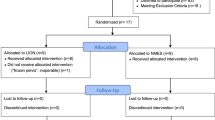Abstract
Setting:
Retrospective analysis and retrospective follow-up.
Introduction:
Spinal cord injury (SCI) patients have today a nearly normal lifespan. Avoidance of medical complications is key to this end. The aim of the study was to analyse health in individuals surviving 25 years or more after traumatic SCI in Stockholm and Florence, and compare medical complications.
Methods:
Data from the databases of the Spinal Unit of Florence and from the Spinalis, Stockholm were analysed. Patients included were C2–L 2, American Spinal Cord Association (ASIA) Impairment Scale (AIS) A–C, and ⩾25 years post traumatic SCI. Patients underwent a thorough neurological and general examination, and were interviewed about medical events during those years. Analysed data include: gender, age at injury, current age, neurological level, AIS, cause of injury, presence of neuropathic pain (NP), and spasticity and medical complications.
Results:
A total of 66 Italian patients and 74 Swedish patients were included. The only statistical difference between the groups was cause of injury due to falls was higher in the Florence group (P<0.01). Male/female ratio was 4:1. Traffic accidents were the most common cause of injury. In all, 60% were paraplegics. Pressure ulcers (PU) occurred in nearly 60% and 32% experienced NP. Respiratory complications (RC) occurred in 25% among tetraplegics. Neurological deterioration occurred in 14%.
Conclusion:
PU, bony fractures, spasticity and NP are important problems after SCI. RC are of clinical importance in the tetraplegics. Complications occur during all periods after injury. Many patients are otherwise healthy 25 years or more after SCI.
Similar content being viewed by others
Log in or create a free account to read this content
Gain free access to this article, as well as selected content from this journal and more on nature.com
or
References
Pagliacci MC, Celani MG, Zampolini M, Spizzichino L, Franceschini M, Baratta S et al. Gruppo Italiano Studio Epidemiologico Mielolesioni. An Italian survey of traumatic spinal cord injury. The Gruppo Italiano Studio Epidemiologico Mielolesioni Study. Arch Phys Med Rehabil 2003; 84: 1266–1275.
Biering-Sörensen F, Pedersen V, Clausen S . Epidemiology of spinal cord lesions in Denmark. Paraplegia 1990; 28: 105–118.
Wuermser LA, Ho CH, Chiodo AE, Priebe MM, Kirshblum SC, Scelza WM . Spinal cord injury medicine. 2. Acute care management of traumatic and non-traumatic injury. Arch 2007; 88 (Suppl 1): S55–S61.
Kirshblum SC, Priebe MM, Ho CH, Scelza WM, Chiodo AE, Wuermser LA . Spinal cord injury medicine. 3. Rehabilitation phase after acute spinal cord injury. Arch Phys Med Rehabil 2007; 88 (Suppl 1): S62–S70.
McKinley WO, Gittler MS, Kirshblum SC, Stiens SA, Groah SL . Spinal cord injury medicine. 2. Medical complications after spinal cord injury: identification and management. Arch Phys Med Rehabil 2002; 83 (Suppl 1): S58–S64, S90-S98.
Ditunno JF, Donovan WH, Maynard FM . ASIAS. In: Ditunno JFDWHM, FM (eds). Reference Manual for the International Standards for Neurological and Functional Classification of Spinal Cord Injury. ASIA: Chicago, 1994.
Black J, Baharestani MM, Cuddigan J, Dorner B, Edsberg L, Langemo D et al. National Pressure Ulcer Advisory Panel National Pressure Ulcer Advisory Panel's updated pressure ulcer staging system. Adv Skin Wound Care 2007; 20: 269–274.
Lee KC, Carson L, Kannin E, Patterson V . The Ashworth scale: a reliable and reproducible method of measuring spasticity. J Neuro Rehab 1989; 3: 205–209.
Siddall JP, Yezierski RP, Loeser JD . Pain Following Spinal Cord Injury: Clinical Features, Prevalence, and Taxonomy, Technical corner from IASP Newsletter 2000, p 3–78.
Chiodo AE, Scelza WM, Kirshblum SC, Wuermser LA, Ho CH, Priebe MM . Spinal Cord Injury Medicine. 5. Long-Term Medical Issues and Health Maintenance. Arch Phys Med Rehabil 2007; 88 (Suppl 1): S76–S83.
McKinley WO, Jackson AB, Cardenas DD, DeVivo MJ . Long-term medical complications after traumatic spinal cord injury: a regional model systems analysis. Arch Phys Med Rehabil 1999; 80: 1402–1410.
National Spinal Cord Injury Statistical Center. National spinal cord injury Fact Sheet 2010. National Spinal Cord Injury Statistical Center: Birmingham, Alabama, 2010.
Werhagen L Budh CN, Hultling C, Molander C . Neuropathic pain after traumatic spinal cord injury – relations to gender, spinal level, completeness, and age at the time of injury. Spinal Cord 2004; 42: 665–673.
Nielsen OA, Biering-Sorensen F, Bötel U, Gardner BP, Little J, Ohta H et al. Post-traumatic syringomyelia. Spinal Cord 1999; 37: 680–684.
Wahman K, Nash MS, Westgren N, Lewis JE, Seiger A, Levi R . Disease risk factors in persons with paraplegia: the Stockholm Spinal Cord Injury Study. J Rehabil.Med 2010; 42: 272–278.
Wahman K, Nash MS, Lewis JE, Seiger A, Levi R . Increased cardiovascular disease risk in Swedish persons with paraplegia: the Stockholm spinal Cord Injury Study. J Rehabil Med 2010; 42: 489–492.
Soden RJ, Walsh J, Middleton JW, Craven ML, Rutkowski SB, Yeo JD . Causes of death after spinal cord injury. Spinal Cord 2000; 38: 604–610.
Lindal IB, Snekkevik H, Aamodt G, Hjeltnes N, Stanghelle JK, Biering-Sorensen F . Mortality after spinal cord injury in Norway. J Rehabil Med 2007; 39: 145–151.
The Swedish Annual Level-of-living Survey. Survey of Living Condition 2003–2005. Swedish Statistics available from www.scb.se/pages/list.
Bauman WA, Spungen AM, Raza M, Rothstein J, Zhang RL, Zhong YG et al. Coronary artery disease: metabolic risk factors and latent disease in individuals with paraplegia. Mt Sinai J Med 1992; 59: 163–168.
Author information
Authors and Affiliations
Corresponding author
Ethics declarations
Competing interests
The authors declare no conflict of interest.
Rights and permissions
About this article
Cite this article
Werhagen, L., Aito, S., Tucci, L. et al. 25 years or more after spinal cord injury: clinical conditions of individuals in the florence and stockholm areas. Spinal Cord 50, 243–246 (2012). https://doi.org/10.1038/sc.2011.130
Received:
Revised:
Accepted:
Published:
Issue date:
DOI: https://doi.org/10.1038/sc.2011.130
Keywords
This article is cited by
-
Fractures and musculoskeletal ailments in persons 20+ years after a traumatic spinal cord injury in Norway
Spinal Cord Series and Cases (2018)
-
Current and future international patterns of care of neurogenic bladder after spinal cord injury
World Journal of Urology (2018)



